Karl Shuker's Blog, page 43
August 24, 2014
CACTUS CATS, SPLINTER CATS, AND SLIVER CATS – THREE AMERICAN FIERCE CRITTERS OF THE FELINE KIND
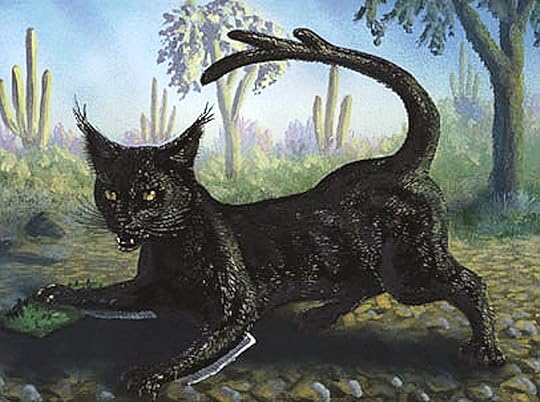 Cactus cat painting (© William Rebsamen)
Cactus cat painting (© William Rebsamen)The lumberjacks, hillbillies, cowboys, and other frontier folk of the early American West created a fascinating, entirely original world of folklore, inhabited by all manner of extraordinary creatures, Collectively termed Fierce Critters, these included several overtly outrageous examples of the feline variety, as exemplified by the highly suspect but wickedly amusing trio presented here.
CAROUSING WITH THE CACTUS CAT
Surely the most memorable of all fictitious felids from the American West is the cactus cat of Arizona, New Mexico, and southern California. On first glance, it simply looks like a rather large but otherwise nondescript black domestic cat, standing about 2 ft at the shoulder and weighing around 30 lb - but look again. Then you will see that its ebony fur is strangely thorny or spiky, especially at the tips of its ears and tail, and also upon its brows. You will also observe that its long tail is branched at the end - but, most striking of all, you will perceive a thin blade of razor-sharp bone running along the edge of each of its two front legs. These blades serve a very important function.
The cactus cat earns its name from its passion for imbibing the sap of cacti, which it obtains by slashing their bases with its front legs' bony blades. Swiftly the sap begins to flow, but the cactus cat refrains from drinking this liquid until it has fermented into a potently alcoholic brew - whereupon it laps up the liquor in an unbridled fervour.
Inevitably, this demented felid becomes ever more intoxicated, until, when finally satiated, it staggers away, screeching and caterwauling uproariously in unabashed, drunken delight, very ready and only too willing to thrash unmercifully with its spiny, lashing tail anything, or anyone, approaching too closely - as many a cowboy, albeit while in a similar state of intoxication himself, has frequently testified.
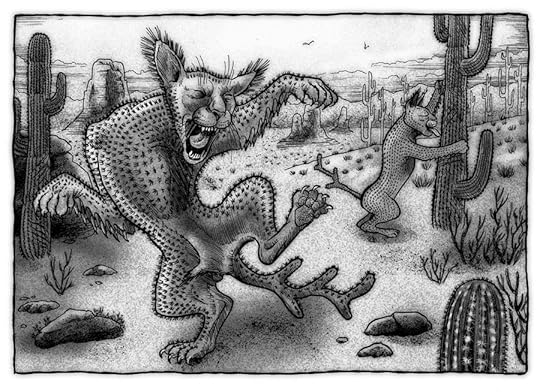 Cactus cat (© Richard Svensson)
Cactus cat (© Richard Svensson)THE SPLINTER CAT – A FELINE BATTERING RAM, OR A MIAOWING RHINO!
The splinter cat must surely be evolution's answer in feline form to the rhinoceros. Feeding upon wild bees and raccoons, the splinter cat has developed a particularly violent means of flushing them out of their arboreal hideaway.
Like an animated battering ram, it charges head-first into a likely-looking tree, crashing its specially-reinforced forehead against the trunk with a thunderous collision. Not surprisingly, any raccoons or bees residing in the tree's branches flee in terror - right into the splinter cat's waiting jaws.
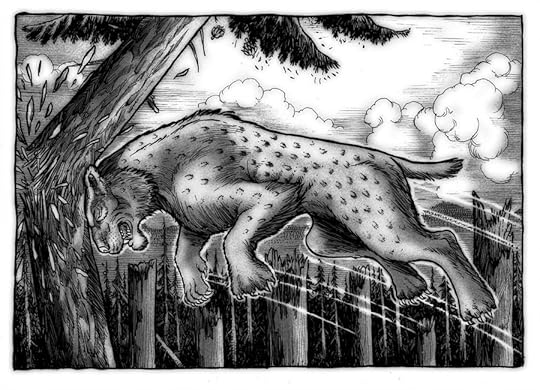 Splinter cat (© Richard Svensson)
Splinter cat (© Richard Svensson)THE SMILE ON THE FACE OF THE SLIVER CAT
Rather more subtle, but no less successful, than that of the splinter cat is the ploy adopted by the sliver cat. Its prey is somewhat larger than the splinter cat's, for it is inordinately fond of lumberjacks. So much so, in fact, that it will spend many hours patiently lying in wait for one to pass by under the branch of a pine tree on which it is lying concealed.
And as soon as one does, the splinter cat smiles sweetly at him - before deftly rapping the hapless tree-feller on top of his head with the smooth side of the hard mace-like knob borne at the tip of its tail.
The other side of this mace is spiked, for good reason - because as soon as it has concussed its victim, the splinter cat uses the spiky side of its mace to hook into the lumberjack's clothing, before hauling his inert body up into the tree, for a close encounter of the fatal kind!
 Sliver cat (© Richard Svensson)
Sliver cat (© Richard Svensson)Further details concerning these and other fabulous felids from North American folklore can be found in my book Cats of Magic, Mythology, and Mystery (2012).
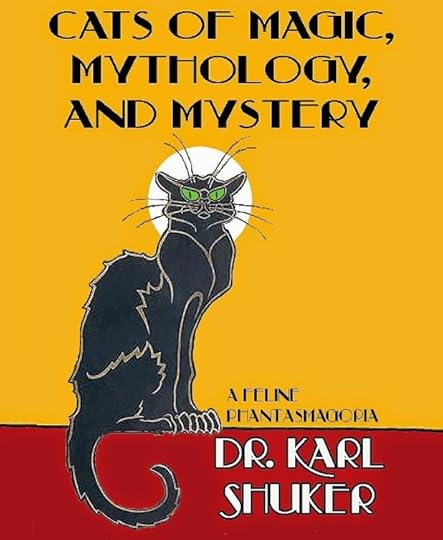
Published on August 24, 2014 14:49
August 22, 2014
DUNG-HEAPS, DEVIL-PIGS, AND MONCKTON'S GAZEKA
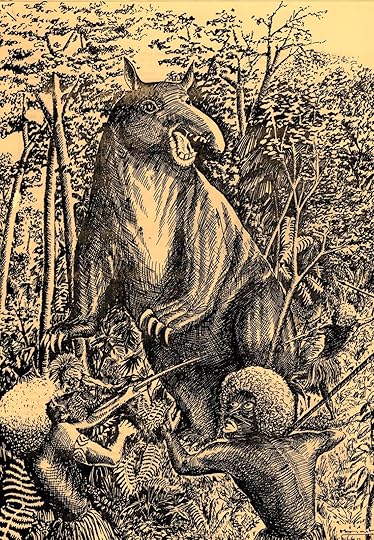 Dramatic depiction of a extra-large devil-pig on the rampage (© Marc Dupont)
Dramatic depiction of a extra-large devil-pig on the rampage (© Marc Dupont)With an area of more than 340,000 square miles, New Guinea is second only to Greenland as the largest island in the world (Australia is bigger than both but is officially deemed an island continent, rather than a mere island). It is divided politically into Irian Jaya or Indonesian New Guinea as its western half (and which itself is divided into two separate Indonesian provinces – Papua, and West Papua, the latter also being called West Irian Jaya) and the independent country of Papua New Guinea (PNG) as its eastern half.
 Map of New Guinea, showing its political division between Indonesia and PNG (© Wikipedia)
Map of New Guinea, showing its political division between Indonesia and PNG (© Wikipedia)Throughout this mega-island's length and breadth, however, are dense and often little-explored rainforests where various surprising new species of animal have been revealed in recent years, including a black-and-white panda-like whistling tree kangaroo known as the dingiso Dendrolagus mbaiso (see my book The Encyclopaedia of New and Rediscovered Animals for full details) - and also where several more may still await discovery, judging from reports on file of certain bizarre beasts that cannot be satisfactorily reconciled by science with any species known to exist here.
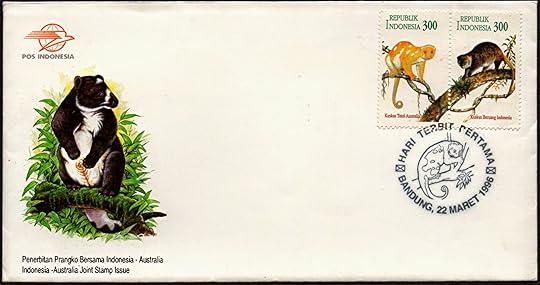 First Day Cover issued in 1996 by Indonesia, depicting a dingiso, and also bearing two cuscus stamps (from my personal philatelic collection)
First Day Cover issued in 1996 by Indonesia, depicting a dingiso, and also bearing two cuscus stamps (from my personal philatelic collection)The history of what must surely be among the most intriguing of these varied New Guinea cryptids began in a distinctly prosaic, unromantic manner - the finding of an unexpected pile of dung. In 1875, the eminent English scientific journal Nature carried a couple of letters from Alfred O. Walker concerning the recent discovery by Lieutenant Sidney Smith and Captain Moresby from H.M.S. Basilisk of a startlingly large heap of fresh dung in a forest while surveying on PNG's north coast, between Huon Bay and Cape Basilisk. Indeed, the pile of excrement in question was so big and its overall appearance was such that the men assumed it to have been left by some form of rhinoceros. Yet there is no known species of rhino native to New Guinea.
The mystery deepened via a further Natureletter of 1875, submitted this time by German zoologist Dr Adolf Meyer, who confirmed that the Papuans inhabiting the south coast of the Geelvinks Bayknew of a rare but very large pig-like creature in the area. And in 1906, two such beasts were finally encountered, albeit in a wholly unplanned manner.
 Portrait of Captain Charles A.W. Monckton from 1899
Portrait of Captain Charles A.W. Monckton from 1899During the spring of that year, explorer Captain Charles A.W. Monckton was leading a major expedition to PNG's Mount Albert Edward. On May 10, two of his team's members, an army private called Ogi and a village constable called Oina, were sent on ahead to investigate a track discovered by the expedition the previous day. Somehow the two men became separated, and while seeking Oina, Ogi came upon two extraordinary creatures grazing nearby.
Although vaguely pig-like, each of these animals was approximately 3.5 ft tall, and 5 ft long, with a very dark, patterned hide, cloven feet, a long snout, and a horse-like (hairy?) tail. Ogi was so frightened by these weird creatures, which he referred to as devil-pigs as he felt sure that they must be demons in porcine guise, that he tried to shoot one, but missed. What happened after that is unclear, because when he was later found by Oina and taken back to camp, Ogi was in a severe state of shock, and unable to recollect anything further.
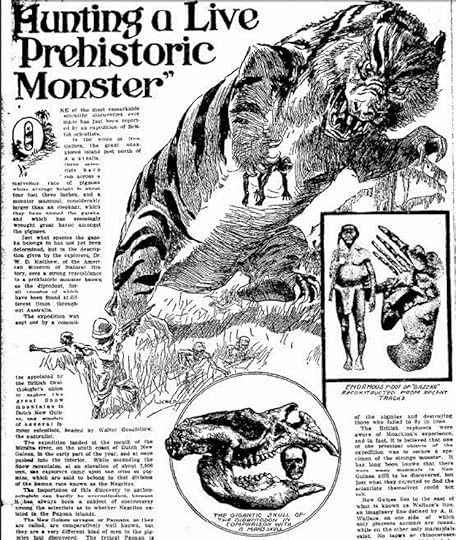 Lurid depiction of the Papuan devil-pig as an implausibly-rapacious, elephant-sized carnivore - from a highly-imaginative report published by the
Stevens Point
,
Wisconsin
, Gazette
in 1910
Lurid depiction of the Papuan devil-pig as an implausibly-rapacious, elephant-sized carnivore - from a highly-imaginative report published by the
Stevens Point
,
Wisconsin
, Gazette
in 1910Intriguingly, Ogi's testimony gained partial support from expedition leader Captain Monckton himself, because he affirmed that some very large cloven-footed tracks had indeed been found on Mount Albert Edward. And a mysterious, unidentified long-snouted beast had also been sighted during an expedition to Mount Scratchley.
There is even native testimony of such a creature from Irian Jaya, gathered in 1910 by Walter Goodfellow in the vicinity of the Mimiko River during an expedition launched by the British Ornithologists Union, and which was the inspiration for a hilariously over-blown and exceedingly exaggerated account published later that same year in an American newspaper, the Stevens Point, Wisconsin, Gazette.
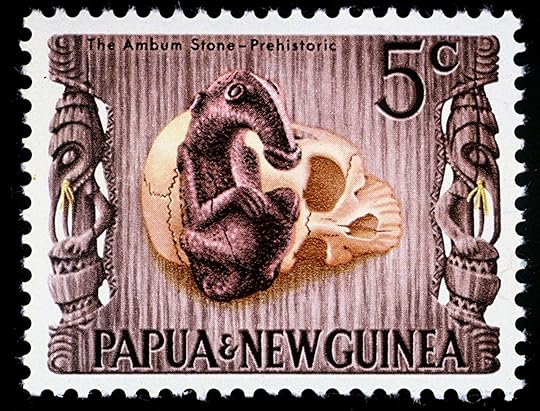 Ambun mystery beast as represented by one of the Ambun stone carvings, and depicted here on a postage stamp issued by Papua New Guinea (NB – the stamp mis-spells 'Ambun' as 'Ambum')
Ambun mystery beast as represented by one of the Ambun stone carvings, and depicted here on a postage stamp issued by Papua New Guinea (NB – the stamp mis-spells 'Ambun' as 'Ambum')Most tantalising of all, however, is a series of stone carvings collected from 1962 onwards in the Ambun Valley of PNG's highlands-situated Enga Province, and only a few millennia old at most. They depict a very odd-looking mammal with a rotund body, forelimbs and hindlimbs clasping its belly, a well-demarcated neck, narrow head, large eyes and ears, and a notable trunk-like snout curving downwards and bearing a pair of flaring nostrils at its tip.
Traditionally, this animal has been identified as a New Guinealong-beaked echidna (spiny anteater) Zaglossus sp., even though the resemblance is superficial at best, as the carved beast lacks spines and its bulky trunk with well-defined nostrils is very different from the echidna's slender tubicolous beak and ill-defined nostrils. Further discrepancies from the carved beast are the echidna's tiny eyes and ears, globular head, and almost non-existent neck.
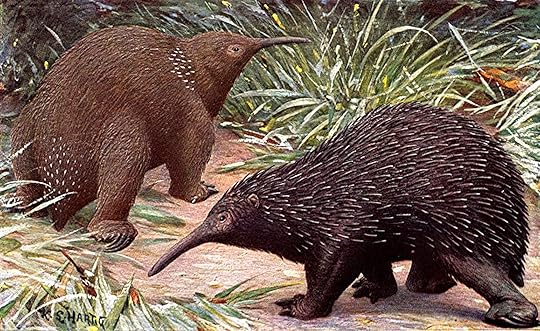 New Guinea long-beaked (Zaglossus) echidnas depicted in a lithograph from 1910
New Guinea long-beaked (Zaglossus) echidnas depicted in a lithograph from 1910In 1987, however, mammalogist James I. Menzies proposed a much more dramatic, yet morphologically more compatible, identity. He claimed that the Ambun beast was a palorchestid diprotodont - a large and very bizarre-looking herbivorous marsupial, which did indeed have big eyes, a short trunk, well-delineated external ears, and other features displayed by the carvings.
Moreover, palorchestids would have looked very like giant pigs or even tapirs in life, and certainly startling enough if encountered unexpectedly to conjure up notions of pig demons or devil-pigs in the minds of frightened locals.
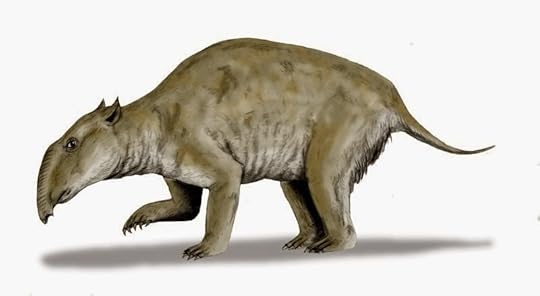 Palorchestid reconstruction (© Nobu Tamura/Wikipedia)
Palorchestid reconstruction (© Nobu Tamura/Wikipedia)The only problem with this persuasive identity is that palorchestids are known from fossil remains only in Australia(none are presently on record from New Guinea), where they became extinct around 13,000 years ago - or did they?
The resemblance between cryptic devil-pig, palaeontological palorchestid, and carved Ambun beast is sufficiently telling to support the exciting possibility that in New Guinea's near-impenetrable, sparsely-explored jungle heartlands, some of these amazing animals still exist, albeit currently unrepresented by uncovered fossils and rarely seen in the living state, with only their tracks - and the odd dung-heap - to betray their presence.
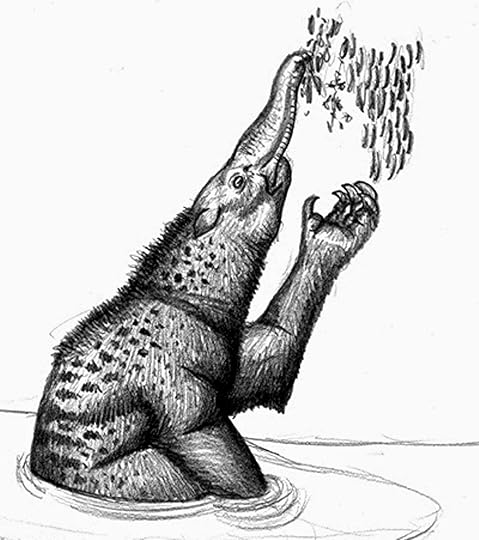 Another palorchestid reconstruction (© Tim Morris)
Another palorchestid reconstruction (© Tim Morris)Incidentally, a longstanding source of much confusion and misinformation regarding the Papuan devil-pig is the application to it by person(s) unknown of the nickname 'Monckton's gazeka'. It is often claimed to be a genuine, official name for this cryptid, supposedly applied to it by English-speakers in New Guinea to honour Monckton – in reality, however, it is actually a somewhat sarcastic put-down of the latter explorer. It derives from an entirely fictitious mystery beast called the gazeka, which was created by English comic actor George Graves, who introduced it in the stage musical The Little Michus at Daly's Theatre, London, in 1905. So popular did Graves's creation become during the early 1900s, moreover, that it even inspired competitions to produce the best illustration of what his imaginary beast may look like
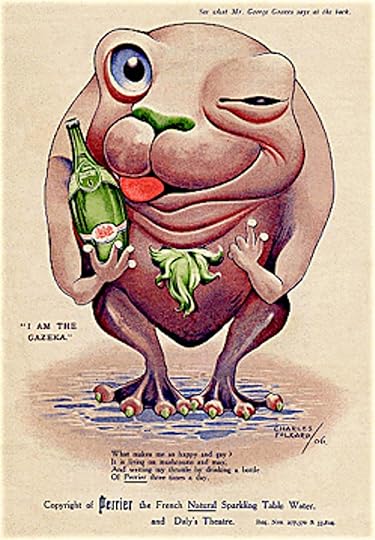 The original gazeka – a depiction of George Graves's version from 1905 as featured in a Perrier's Water advertisement (public domain)
The original gazeka – a depiction of George Graves's version from 1905 as featured in a Perrier's Water advertisement (public domain)According to Graves, the gazeka had been discovered by an explorer accompanied on his travels by a case of whiskey, and who thought he may have seen it once before, in some form of dream. Clearly, therefore, whoever shortly afterwards dubbed the Papuan devil-pig 'Monckton's gazeka' was utilising Graves's then-famous creature creation to make a sly, topical dig at Monckton's expense, implying that he had dreamt up the devil-pig, possibly while under the influence of alcohol!
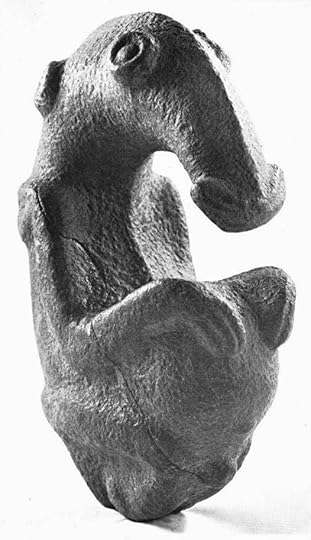 Photograph of the Ambun stone mystery beast (photo source unknown to me)
Photograph of the Ambun stone mystery beast (photo source unknown to me)Further information concerning the Papuan devil-pig can be found in my book In Search of Prehistoric Survivors .
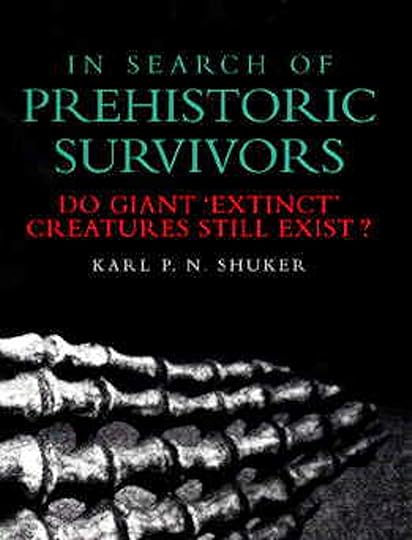
Published on August 22, 2014 14:17
August 20, 2014
AN EIGHT-LEGGED SIREN FROM FRANCE - A SINGING GIANT SPIDER FROM THE CATACOMBS OF ISSOIRE
 'Spider's Room' (© Minhee-Kim/Deviantart.com – for additional, equally spectacular artwork by this extremely talented digital artist from South Korea, please click
here
)
'Spider's Room' (© Minhee-Kim/Deviantart.com – for additional, equally spectacular artwork by this extremely talented digital artist from South Korea, please click
here
)On 23 August 2014 at 10 pm Pacific Time in the USA and on 24 August 2014 at 6 am in the UK, I shall be appearing on Coast To Coast AM's radio show in an hour-long interview, talking about giant spiders of the cryptozoological kind. The interview follows on from my recent, very popular ShukerNature blog post on this same subject (click here ), which in turn was excerpted from the extensive chapter devoted to such creatures that appeared in my book Mirabilis: A Carnival of Cryptozoology and Unnatural History (Anomalist Books: New York, 2013), and which is the most comprehensive account of giant crypto-spiders ever compiled and published.
Now, as a foretaste of my upcoming radio interview, here is a further excerpt from that same chapter in Mirabilis – but if you're an averred arachnophobe, this may be a good time to turn away and read something else instead!
 Awesome giant spider artwork (© Alderac Entertainment Group)
Awesome giant spider artwork (© Alderac Entertainment Group)What must surely be the most bizarre of all giant spider reports featured a veritable siren, albeit one with eight legs instead of a fishtail, yet equally as gifted musically (not to mention homicidally) as any of Greek mythology's lethal mermaids.
The earliest documentation of it that I have so far uncovered is a detailed account in the Ann Arbor Argus newspaper for 14 September 1894, which was subsequently reiterated in various other American newspapers. According to this extraordinary journalistic concoction of Grand Guignol and cryptozoology, during late March (and invariably at night) each year for many years, men and women had inexplicably been disappearing in a region of Paris known as the Tomb of Issoire, without any trace of them ever being discovered. One night, however, a policeman in this vicinity happened to hear a strange musical song issuing forth from a hole at the base of a huge rock there, dubbed the Giant's Cave due to the legend that a giant had been buried there long ago.
As the policeman stood listening, he saw a young man approach the hole, seemingly hypnotised by the unearthly strains issuing forth from their hidden subterranean source, and then suddenly the man raced into the hole at full speed. The policeman chased after him, firing his revolver to alert some of his colleagues for back-up as he entered the hole. They soon arrived, by which time the strange music had ceased, its mysterious melody having been replaced by the sounds of a violent struggle. Arming themselves with ropes, ladders, and lamps, the policeman's colleagues swiftly penetrated the chasm into which the hole led, and beheld a terrifying sight.
The young man, dead, was in the grip of a monstrous spider, which according to the newspaper report was:
"...as large as a full grown terrier, covered with wartlike protuberances and bristling with coarse brownish hair. Eight jointed legs, terminated by formidable claws, were buried in the body of the unfortunate victim. The face had already disappeared. Nothing could be seen but the top of the head, and the monster was now engaged in tearing and sucking the blood from his throat."
Several blasts from the policemen's guns soon dispatched this horrific creature, after which they found their colleague lying in a corner, unconscious but unharmed. They then carried the two men and the carcase of the great spider back out through the hole into the Parisian street where this surreal incident had begun.
In an even more bizarre twist to this already exceedingly weird tale, however, the newspaper report ended by claiming that the spider belonged to a species hitherto deemed extinct for centuries, named as Arachne gigans, which supposedly possessed the ability to entice its victims by giving voice to a mesmerising song, and which may be represented by additional live specimens still existing in the deepest galleries of this city's catacombs. But what happened to the slain Issoire mega-spider? According to the report:
"The dead body of the spider was conveyed to the Museum of Natural History, where it was carefully prepared and stuffed and is now on exhibition. – Once a Week."
The museum was presumably France's National Museum of Natural History, in Paris, but it will come as no surprise to discover that the museum has no record of ever even receiving, let alone exhibiting, such a singular specimen. Nor is there any such species as Arachne gigans, living or extinct.
During the late 19th Century and early 20thCentury, it was commonplace for newspaper editors to spice up their publications with lurid tales of extraordinary discoveries and events that had no basis in reality. And certainly, there seems very little doubt that the giant singing spider of Issoire only ever existed within the fevered imagination of an editor anxious to fill up some spare column inches inside his newspaper.
Be sure to check out the entire chapter on giant spiders in my book Mirabilis: A Carnival of Cryptozoology and Unnatural History (2013), and I hope that you will be able to listen to my Coast To Coast AM interview on this bloodcurdling subject during the coming weekend.
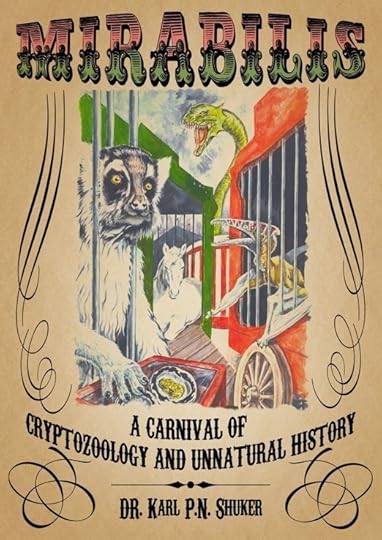
Published on August 20, 2014 09:31
August 15, 2014
THE DAS-ADDER – A HYRAX-HEADED HYPNOTIST?
 Computer-created simplistic rendition of the das-adder's supposed appearance (© Dr Karl Shuker)
Computer-created simplistic rendition of the das-adder's supposed appearance (© Dr Karl Shuker)South Africa's Drakensberg Range is supposedly home to a remarkable creature known locally as the das-adder, which has been reported for well over a century here. 'Dassie' is an alternative name for a hyrax – those small, rabbit-like hoofed mammals whose closest living relatives are the elephants. The das-adder derives its name from its head, which allegedly resembles that of a dassie, and its sinuous body, reminiscent of an African puff adder's. Many native people sharing its provenance claim that this curious mystery beast is extremely venomous and even capable of hypnotising its victims with a single stare.
 Rock hyrax or Cape dassie Procavia capensis, native to southern Africa (© Arikk/Wikipedia)
Rock hyrax or Cape dassie Procavia capensis, native to southern Africa (© Arikk/Wikipedia)In 1940, W.L. Speight published a lengthy article on African mystery beasts in the journal Empire Review, and included a detailed account of the das-adder. Speight stated that its tail was marked with yellow and red stripes, its external ear openings were folded into a crest, and in the opinion of some authorities this cryptid was not a snake at all, but rather a large lizard, with a 2-ft-long tail.
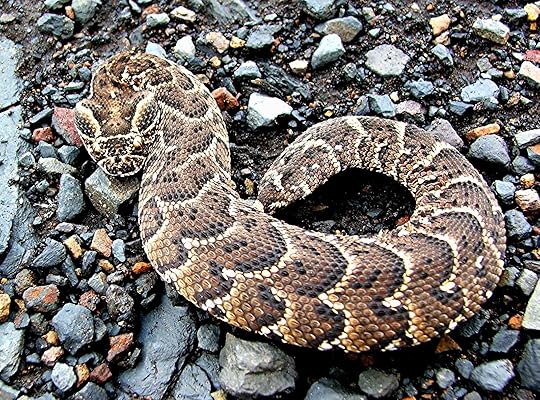 Juvenile African puff adder Bitis arietans ready to strike (public domain)
Juvenile African puff adder Bitis arietans ready to strike (public domain)One of those authorities was 19th-Century zoologist Dr Andrew Smith of the Cape Town Museum, who was so intrigued by stories of the das-adder that he even advertised for a specimen to be brought to him for examination, but his advert did not elicit any specimens. In his view, this elusive beast was probably based upon nothing more dramatic than poor observation of the Cape rock monitor Varanus albigularis, slipping half-hidden between rocks and boulders so that its limbs were concealed from view.
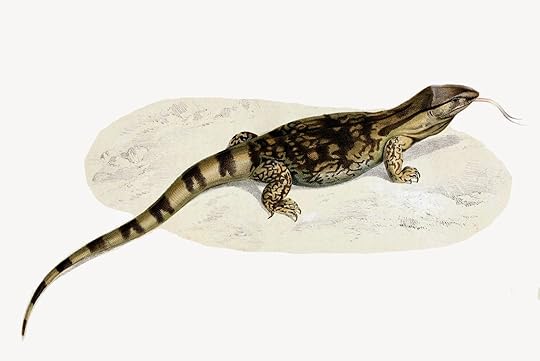 Cape rock monitor Varanus albigularis, illustration from 1838
Cape rock monitor Varanus albigularis, illustration from 1838An entertaining idea, but as this varanid does not have a red and yellow tail or a hyrax-comparable head, it leaves rather a lot to be desired as a convincing identity for the das-adder - which, sadly, seems today to have become virtually forgotten, even among cryptozoologists, with its status still unresolved.
This ShukerNature post is adapted from my book From Flying Toads To Snakes With Wings
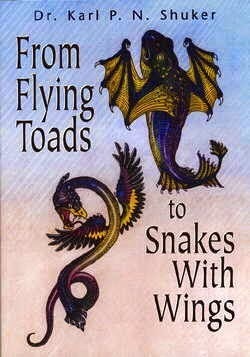
Published on August 15, 2014 08:36
August 12, 2014
A NOVEL INSTANCE OF RED EYE-GLOW POTENTIALLY RELEVANT TO CRYPTOZOOLOGY AND ALSO TO THE PARANORMAL
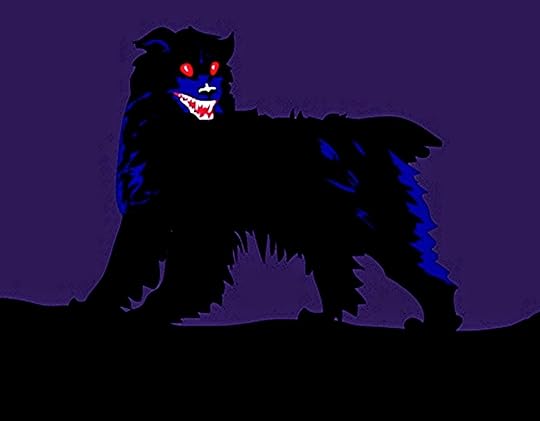 A preternatural Black Dog with glowing red eyes (public domain)
A preternatural Black Dog with glowing red eyes (public domain)The article reproduced below in this present ShukerNature post was the first one of mine to be published in Strange Magazine, way back in November 1991. Its subject is a fascinating case of red eye-glow whose very singular nature provides a truly unique insight into this anomalous phenomenon – one that has been reported both with tangible, corporeal creatures of cryptozoology and with zooform entities of a seemingly supernatural, paranormal nature.
In order to read my article's text, please click on this image of it to enlarge it:
 My red eye-glow article from Strange Magazine (© Dr Karl Shuker/Strange Magazine)
My red eye-glow article from Strange Magazine (© Dr Karl Shuker/Strange Magazine)
Published on August 12, 2014 19:32
August 5, 2014
ANIMAL GRIEF AND MOURNING

They may look very different from us, but a wide range of other animals outwardly express grief and react to death, especially with regard to relatives or longstanding companions, in ways that are extraordinarily - even, on occasion, eerily - similar to our own responses.
THE SORROW OF FAMILY BEREAVEMENTIt should come as no surprise that our nearest relatives, the apes and monkeys, experience grief when confronted with the death of a close relative, but what is startling is just how profound such sorrow can sometimes be. Dr Jane Goodall recorded one harrowingly moving case during her classic researches into the behaviour of wild chimpanzees.
In 1972, while Goodall was studying a community of common chimpanzees Pan troglodytes in Tanzania's Gombe National Park, its matriarch, an elderly female called Flo, died. Flo had been in the company of her 8½-year-old son, Flint, who, unlike most adult chimps, had always remained with his mother rather than becoming independent. Flint initially appeared bemused by her death, sitting alongside her throughout that first day, sometimes inspecting her body, grooming her, and even pulling her hand towards him, hoping that she would groom him in return. When evening came, he constructed a small nest for himself in a tree. Here he passed the night - the very first that he had ever spent alone. Although distracted for a time the next day by his brother's chimp group, it was not long before Flint had returned to the place where Flo had died, and just sat there, staring. Later, he climbed a tree to visit a large nest where he and Flo had slept a week earlier, then he climbed down again, and continued staring.
As the days passed, it was evident that Flint was sinking ever further into a state of deep depression, showing no interest in anything or any other chimp in his community, and not eating, just lying huddled on the ground. His eyes had sunk back into their sockets, and when he did move it was as if he had prematurely aged, shambling like an old chimp. Three weeks after Flo's death, Flint returned once more to the place where she had died, and lay down there, staring out vacantly. Shortly afterwards, he died - of grief, in Goodall's opinion. And certainly, in view of how very closely Flint's behaviour had mirrored the grieving of a bereaved human, it would be difficult indeed to draw any other conclusion.
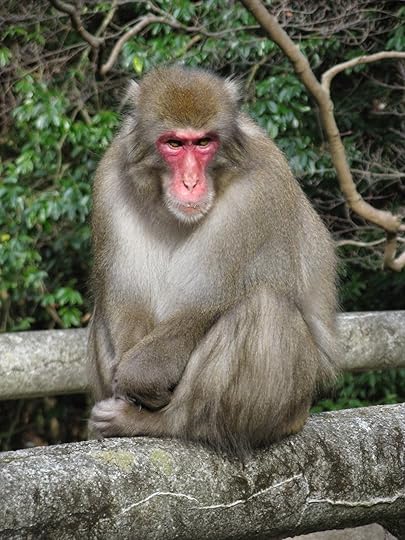 Japanese macaque (© Kenpei/Wikipedia)
Japanese macaque (© Kenpei/Wikipedia)Similarly, while television wildlife producer George Page was filming a group of Japanese macaques Macaca fuscatafor a TV documentary, one of the macaques gave birth to a stillborn infant. Instead of abandoning it, however, its mother carried its body everywhere with her. And each night, after climbing one specific tree with it in her arms, she would give voice to a series of heart-rending screams. Not until three full days and nights of what can only be described as mourning had passed did she finally place her baby's body on the ground and leave it.
Grief and mourning are not confined to primates either. While studying baboons in Kenya, Michigan University behaviourist Dr Barbara Smuts once witnessed four baboons chasing an infant impala Aepyceros melampus. Despite its mother's attempts to protect it, one of the baboons succeeded in seizing the baby antelope, killing it, and eating it in front of its mother. After the baboons left, she remained there, staring down motionless at her calf's devoured remains. And when Smuts revisited the site several hours later, the female impala was still there, and was still gazing fixedly at her dead calf. Moreover, exactly the same scene met Smuts's eyes when she returned there the next morning. It was as if the mother impala had been turned to stone, or had been physically rooted to the spot where her offspring had been so brutally killed. Later that day, she finally departed, but - whether through shock, genuine grief, or both - for over a day she had ignored the world and all of its dangers that she would normally have been so intent upon monitoring, to pay silent homage to her dead calf.
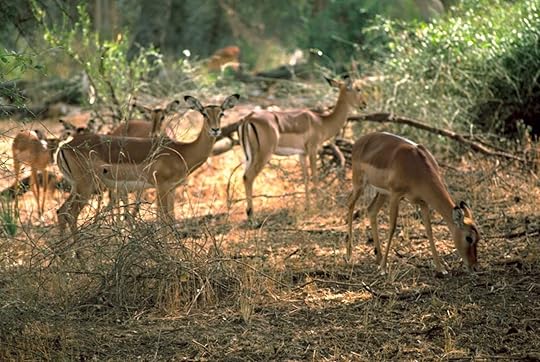 Impala (public domain)
Impala (public domain)Even birds, especially species that mate for life, exhibit unmistakable signs of grief when their partner dies, as revealed by eminent animal behaviourist Prof. Konrad Lorenz:
"A greylag goose that has lost its partner shows all the symptoms that John Bowlby has described in young human children in his famous book Infant Grief. The eyes sink deep into their sockets, and the individual has an overall drooping experience, literally letting the head hang."
Indeed, with swans it is not unknown, if one member of a longstanding pair should die, for the surviving member to stop eating and die within a short time afterwards.
GRIEVING FOR DEPARTED FRIENDSThe grief experienced by pet dogs, cats, and other higher species following their owner's death is often plain for all to see. Moreover, emotional responses have also been documented with animals confronted by the death of an unrelated but familiar animal companion.
In the 1960s, animal rescuers Ken and Mary Jones of Cornwall received a young seal for care, one of many coated with oil spilling forth at that time from the beached oil tanker Torrey Canyon. Naming him Simon, they nursed him back to health at their wildlife sanctuary, and while he was there they received another young seal, this time a female, dubbed Sally, who had been blinded by the oil. Simon and Sally soon became firm friends, and Simon patiently acted as Sally's eyes. Sadly, however, a year later Simon fell ill, and despite the Jones' best efforts to save him, he died. Sally was very distraught at the loss of Simon, lying next to his body and refusing to move from the spot, even after his body had been taken away. Sally rejected all enticements by the Joneses to eat, and in under a week she too had died - not from physical illness, however, but wholly from grief.
 Icelandic pony (© Dr Karl Shuker)
Icelandic pony (© Dr Karl Shuker)The same tragic fate almost befell an elderly female donkey named Julie. As recalled by zoologist Dr Maurice Burton in Just Like an Animal (1978), Julie had spent many years in the company of Leonardo, an old Icelandic pony. Finally, however, the day arrived when Leonardo was so ill that the only option for his owners was to have him put to sleep. So Julie was taken into a field some distance away from the shed where she and Leonardo lived together, while Leonardo was euthanased in the shed. When his body had been removed, Julie was released, but despite her own advanced years she galloped straight across the field to the shed where she had last seen Leonardo. After standing inside for a short time, looking down at the spot where he had been lying, Julie came out of the shed again, raised her muzzle skywards, and gave voice to an unearthly, agonised scream, unlike anything normally emitted by donkeys. After that, she stopped eating, and seemed destined to join Leonardo in death before long - until fate intervened, in the form of a Shetland pony, introduced as a companion on the suggestion of one of her owners' friends. Julie and the pony became good friends, her appetite returned, and several years later the two could still be seen together.
MAYBE AN ELEPHANT NEVER DOES FORGETNo less moving is the reverent loyalty and apparent recognition shown by elephants to the mortal remains of other elephants, especially dead relatives, while totally ignoring the bones of other animals. Amboseli-based elephant researcher Cynthia Moss has revealed that an elephant herd will make a considerable detour from their normal route to investigate unearthed elephant skeletons, and will gently run their trunks along the contours of these bones (particularly the skulls and tusks), fondle them, smell them, and even carry them away for quite a distance before finally dropping them again. One seven-year-old elephant in a herd came upon the jaw of his dead mother, brought by Moss into the research camp at Amboseli in the hope of uncovering its age. Long after the others in his herd had moved on, this elephant remained there, touching and turning over his mother's jaw with his trunk and feet. Did he recognise it as his mother's, from its shape or even its scent, perhaps? And if so, what were the thoughts passing through his mind?
DO ANIMALS CRY EMOTIONAL TEARS?Elephants that have been separated from relatives weep copious tears from their temporal glands when reunited. Moreover, these sizeable mammals weep 'true' tears too, i.e. secreted from their lachrymal glands. Such tears are normally for lubrication purposes - but they are also allegedly wept at times of grief or fear. Young elephants orphaned when their mothers were killed by poachers for their tusks are known to wake screaming in the night, their eyes full of tears. And in their compelling book When Elephants Weep (1994), animal behaviourists Dr Jeffrey Masson and Susan McCarthy include several reports of captive elephants seen weeping when ill-treated by their human masters.
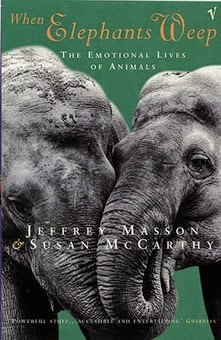 When Elephants Weep (© Jeffrey Masson and Susan McCarthy/Random House)
When Elephants Weep (© Jeffrey Masson and Susan McCarthy/Random House)Equally, when researching for their bookCrying, the Mystery of Tears (1985), Minnesota-based biochemist Dr William Frey and Muriel Langseth received many letters from dog owners claiming that their pets had wept emotional tears. Among the more thought-provoking examples are: an Irish setter that cried when the family cat died; a Boston terrier that hid under the table and sobbed tears whenever his owner scolded him; several reports of weeping Mexican hairless dogs (this breed is apparently famous among devotees for crying if upset); and, most compelling of all, a pomeranian who, when confined in the bathroom by his owner's mother while looking after him, lay on the floor "...with his head resting on his paws and big tears were rolling down his face. His whole body was shaking as he sobbed; the sounds were coming from deep within".
ARE ANIMAL FUNERALS AND BURIALS MORE THAN A LEGEND?Traditional folklore throughout the world tells of animals attending funerals for members of their own kind, and also burying their dead. However, some wildlife observers claim that such events sometimes occur in real life too. Elephants are well known for standing around a dead member of their herd in solemn, almost ritualistic manner, noticeably with their heads pointing away from the body, and adult females have sometimes been witnessed placing leaves or branches over the body of a dead calf.
Badgers are said to bury their dead, and naturalist Brian Vesey-Fitzgerald reported how an adult female European badger Meles meles, after emitting a macabre scream at her sett's entrance, had been seen to dig a large hole nearby and then, assisted by an adult male badger, proceed to pull the dead body of another male out of her sett, deposit it in the freshly-dug hole, and cover it with soil, after which the two went off on their separate ways. Sceptics suggest that badgers are merely caching corpses to be eaten later. In February 1996, however, a Daily Telegraph reader from Guildford reported discovering the dead body of one of his pet rabbits inside a tunnel that had been specifically closed-off by his other rabbits within the tunnel system in which they all lived. Yet rabbits don't eat each other!
 European badger (© BadgerHero/Wikipedia)
European badger (© BadgerHero/Wikipedia)Most bizarre of all are the various reports on file of alleged bee mourners. These are honeybee swarms that have mysteriously appeared at the funeral of their beekeeper. A recent case featured Shropshire beekeeper Margaret Bell, who died in June 1994. Although she lived in Ludlow, Mrs Bell kept her bees 11 km away in Leintwardine. Nevertheless, shortly after her funeral in Ludlow, a huge swarm of bees suddenly appeared and settled on the corner of the street directly opposite her house, staying there for roughly an hour before flying away again. Just an odd coincidence, or were these insects truly Mrs Bell's bees that had somehow found their way from Leintwardine to pay their last respects to their keeper?
This ShukerNature article is excerpted from my book The Hidden Powers of Animals: Uncovering the Secrets of Nature .

Published on August 05, 2014 16:43
July 29, 2014
GIANT SPIDERS – MONSTROUS MYTH, OR TERRIFYING TRUTH?
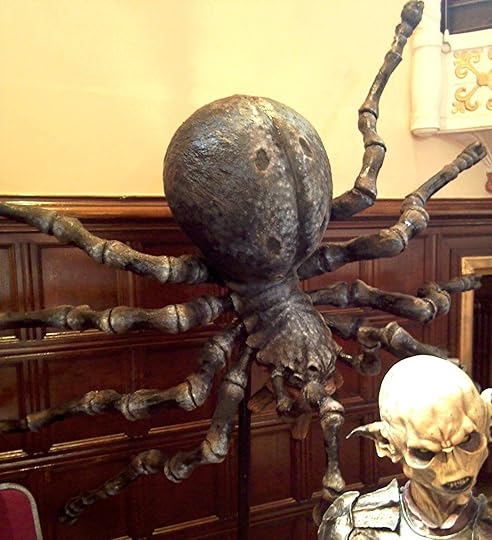 Model of Shelob from Tolkien's classic trilogy of fantasy novels The Lord of the Rings (© Dr Karl Shuker)
Model of Shelob from Tolkien's classic trilogy of fantasy novels The Lord of the Rings (© Dr Karl Shuker)Monstrous spiders of gargantuan size are perennially popular subjects in science fiction 'B' movies as well as in classic fantasy novels such as J.R.R. Tolkien's TheLord of the Rings trilogy and The Hobbit, but could such beasts exist in reality? The current record-holder for the title of world's largest spider is Rosi - a 12-year-old captive female specimen of South America's goliath bird-eating spider Theraphosa blondi (click here for a separate ShukerNature blog article revealing the outcome when T. blondi was formally challenged recently for its title as world's largest spider species by a near-legendary competitor). Rosi boasted a leg-span of 11.25 in (big enough to cover a dinner plate), a body weighing 6.17 oz (which is as heavy as six house sparrows Passer domesticus) and as big as a tennis ball, plus a total body length of 4.75 in.
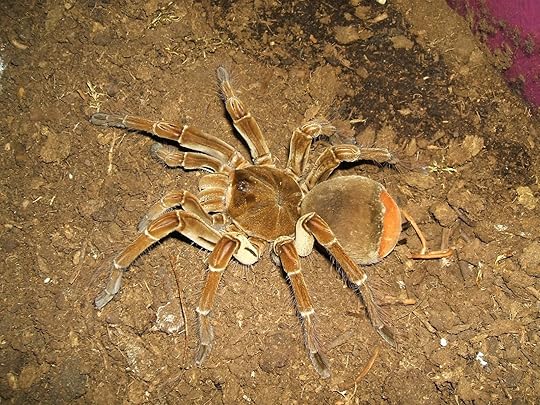 An adult female Theraphosa blondi (public domain)
An adult female Theraphosa blondi (public domain)Although these are impressive statistics, they are far from monstrous. In contrast, as I reveal in this present ShukerNature blog article, there are some remarkable yet currently-unresolved modern-day reports on file hinting that certain truly astonishing arachnids whose size very dramatically surpasses this latter species' stature lurk in shadowy zoological anonymity within various regions of our world.
A PUPPY-SIZED SPIDER IN PAPUA NEW GUINEAThe Kokoda Track (or Trail) is a predominantly straight, single-file foot thoroughfare running 60 miles through inhospitable terrain across the Owen Stanley mountain range of Papua New Guinea, and from July 1942 to January 1943 it was the site of a series of World War II battles between Australian and Japanese forces known as the Kokoda Track Campaign. In 2001, Australian cryptozoologists Peter and Debbie Hynes revealed that it was also here, while serving as a soldier in the Australian Army, that the father of one of Debbie's friends had a brief but unforgettable encounter with a mystery mega-spider:
"One day he had to take himself off into the scrub in answer to a call of nature. While thus engaged he noticed he was crouched down next to a very large cobweb - not the classic "fishing-net" sort but the fine, snow-white cottony stuff that spread all over the ground and tree trunk etc. His eye followed it one way and then the other - seems it was very extensive, like 10 to 15 ft either way. Then he noticed the spider itself, only a foot or so away from his face. It was a real horror - the body, i.e. thorax+abdomen, he described as the "size of a small dog or puppy", it was coloured jet black, the legs were thick and hairy but not as long as the classic "dinner plate tarantula" type spider that owes its size to the spread of its legs. This thing had more body bulk than spread. Needless to say he backed out of there very slowly and carefully."
In spiders, the 'body' is actually just the abdomen (opisthosoma), not the thorax plus abdomen (although it can look like that to laymen unfamiliar with spider anatomy), because the thorax section is combined with the head, yielding the prosoma or cephalothorax. So, judging from the above description, the Papuan 'puppy spider' must have been at least the size of an adult chihuahua!
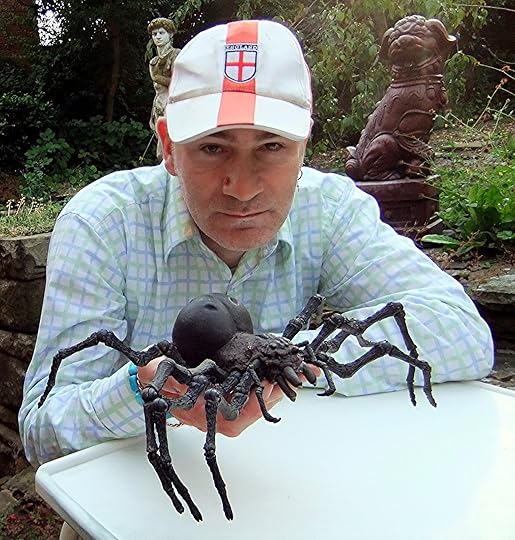 With a model of a giant spider (© Dr Karl Shuker)
With a model of a giant spider (© Dr Karl Shuker)This is not the only report of a giant mystery spider encountered in New Guineaduring World War II. During an interview with cryptozoologist Rob Morphy of AmericanMonsters.com on the U.S. radio show 'Coast To Coast AM' a couple of years ago, a telephone caller named Craig recounted how his grandfather, while serving in New Guinea during WW2, encountered a monstrous spider in a web that scared him so much he hacked it to death with his machete. According to Craig's grandfather, the spider measured an immense 3 ft from tip to tip, and, unexpectedly, was not hairy like many big spiders are. Instead, it was shiny, and was emerald green in colour. This nightmarish arachnid was encountered near Port Moresby, the capital of Papua New Guinea.
J'BA FOFI – 'GREAT SPIDER' OF THE CONGOYet even this monster pales into insignificance alongside the horrifying j'ba fofi ('great spider') claimed by the Baka pygmy tribe and also the local Bantu hunters to exist amid the central African jungles of Cameroonand also the Democratic Republic of Congo (formerly the Belgian Congo). This eight-legged terror was first brought to attention in 2001, when cryptozoological explorer Bill Gibbons told me of a very frightening close encounter that had occurred one day back in 1938.
This was when explorers Reginald and Margurite Lloyd were driving along a jungle path in the Belgian Congo's interior. Suddenly, a figure stepped out onto the path just ahead of them, resembling a monkey or a small, stooped human. Reginald Lloyd stopped the car to let the figure pass, and was astonished to see that it was a huge brown tarantula-like spider, with a leg-span of 3-4-ft! As he turned to grab his camera, however, the giant spider scuttled into the undergrowth and disappeared.
 Reginald and Margurite Lloyd, Congolese giant spider observers (public domain)
Reginald and Margurite Lloyd, Congolese giant spider observers (public domain)In November 2003, during an expedition to Cameroonseeking a mysterious long-necked water beast called the mokele-mbembe, Gibbons mentioned to the Baka pygmies the Lloyds' sighting (originally recounted to him by their daughter, Margaret). They were familiar with such creatures and provided him with additional information.
The Baka claimed that these colossal spiders were once quite common in this area but are rarer now (due to modern deforestation here?), although one was reputedly sighted by them as recently as June 2003. They used to construct hut-like lairs from leaves near to the pygmies' villages, and by spinning mighty webs between adjacent trees, with trip lines running across game trails, they ensnared and devoured victims as sizeable as duiker (small antelopes). Moreover, they were said by the Baka to be powerful and venomous enough to kill humans too, but are themselves killed by the pygmies if encountered by them. The j'ba fofi supposedly lays white peanut-sized eggs, from which yellow spiderlings with purple opisthosomas emerge, turning brown as they mature.
SOUTH AMERICAN MEGA-SPIDERSReports of comparably massive spiders have also been recorded from the rainforests of Venezuelain South America. In 2008, the American television series 'MonsterQuest' sent tarantula expert Rick C. West to investigate such stories in the field via a short, filmed expedition to some Venezuelan jungle villages near to the Orinoco River and the border with Colombia. During his three-day foray, he was accompanied by a team of local helpers and an experienced Amazon guide, Juan Carlos Ramirez, who has worked here for over 20 years.
West began his quest by visiting the village of San Rafael de Manuare. Here, one villager attested that as a child he had seen a giant tarantula-like spider capture a small dog from the village and drag it off into the jungle. Its opisthosoma was as big as a basketball, and when it reared up it was the size of a human. If such a gigantic spider existed, and its fangs (chelicerae) were in proportion to the rest of its body, they would probably measure 6-9 in long. Although such claims would incite considerable scientific scepticism, Ramirez was convinced of the villagers' veracity, stating that they know the local fauna very well, and would not mistake something familiar, such as a monkey or a sloth on the ground, for a giant spider.
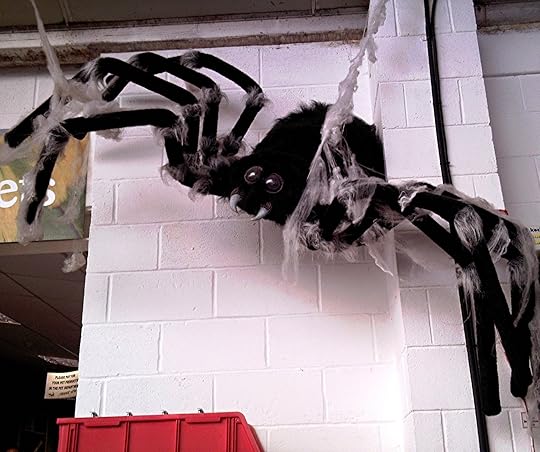 Don't look now, but… (© Dr Karl Shuker)
Don't look now, but… (© Dr Karl Shuker)West and his team also visited Pandari, a village deeper in the mountains. Here, two inhabitants, Antonio and his son Simoni, spoke of a small child who had disappeared, never to return – which had been blamed upon giant spiders. In addition, so real is the Pandari villagers' fear of such creatures that they even engineer their huts specifically to keep them out, building thatched roofs that extend all the way down to the ground, thus yielding dense tightly-interwoven barricades.
On the third day of West's expedition, they headed back into the jungle and found an extremely large spider lair in the ground, inside which they placed a videoscope. This revealed the presence there of a very big tarantula, which they captured alive. Although nothing like as sizeable as the reputed chicken-killing, dog-devouring, child-abducting specimens feared by the villagers, it was roughly the same size as the biggest tarantulas on record and was 2 oz when weighed inside a plastic specimen bag.
Sadly, West's expedition ended without finding conclusive evidence for Venezuela's fabled giant spiders. However, he was sufficiently impressed by the size of their captured spider to consider it possible that bigger ones did exist in the jungle, and stated that he planned on returning to continue the search for one.
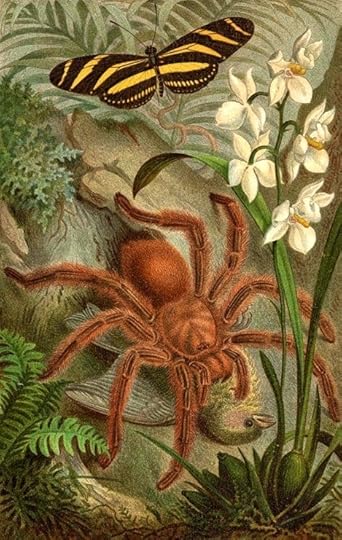 Bird-eating spider, illustrated by Louis Prang in 1885
Bird-eating spider, illustrated by Louis Prang in 1885In 2011, British cinematographer Richard Terry sought horse-killing, child-abducting giant spiders in Colombia's rainforest, for the television series 'Man v Monster'. He didn't find any either, but villagers claimed that these dreaded beasts inhabited subterranean lairs opening onto the forest floor via huge holes.
MONSTER SPIDERS IN VIETNAMOn 8 April 2013, American cryptozoologist Craig Woolheater posted on the Cryptomundo website a fascinating communication that he'd lately received from an American correspondent publicly identified only by their Cryptomundo user name, mrmaxima. This person stated that their father-in-law claims that while serving in the jungles of Vietnam during the Vietnam War as part of a five-man unit conducting scout work there, he encountered spiders with bodies the size of dinner plates, and, with their legs, yielding a total span of 20-30 in. These terrifying arachnids were always spied near to creeks or other water sources, and were so tough that even after being shot by him and the other men with their M16s and unloaded full magazines, they were still moving around.
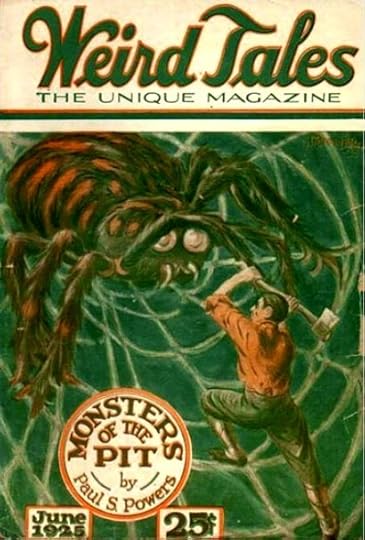 Weird Tales
magazine cover, June 1925 issue
Weird Tales
magazine cover, June 1925 issueGIANT SPIDERS IN SUBURBIAOne of the most startling giant spider reports comes from Leesville in Louisiana, USA. According to William Slaydon, it was here, while walking northwards along Highway 171 to church one cool night in 1948, that he, his wife, and their three young grandsons had spied a gigantic spider - hairy, black, and memorably described as "the size of a washtub". It emerged from a ditch just ahead of them and crossed the road before disappearing into some brush on the other side. Not surprisingly, the family never again walked along that particular route to church at night!
 A very erudite arachnid of the extra-large variety? (© Dr Karl Shuker)
A very erudite arachnid of the extra-large variety? (© Dr Karl Shuker)Nor is that the only report of a giant spider in suburbia. On 11 February 2013, Adam Bird from Nottingham, England, shared the following remarkable, never-before-publicised account on Facebook. It was related to him by a local librarian, Sheila, who had encountered the spider in question about 12 years earlier. One evening, Sheila was driving along Nottingham's Stone Bridge Road, on one side of which was a farm (still there today) and on the other side a disused factory (now demolished). As she approached the factory, her car's headlights lit up what she thought at first was a hedgehog, crawling towards the factory site. As she drove nearer, however, she realised to her horror that it was a huge, hairy, tarantula-like spider. Sheila estimated that its body alone was the size of a large dinner plate, and when the length of its legs were added, she deemed its total width to be about 2 ft. She continued to watch as it scuttled across the road and through the fence into the factory, then she quickly drove away, but, not surprisingly, the memory of this spine-chilling encounter has remained with her ever since.
PHYSIOLOGICAL SIZE LIMITATIONSBut what about the other monsters reported here – could immense spiders truly exist? Other than Leesville and Nottingham, the areas where they have been reported are all sufficiently impenetrable, inhospitable, and little-explored to be potentially capable of hiding some notable zoological surprises. However, the fundamental problem when considering giant spiders is not one of zoogeography but rather one of physiology.
Their tracheal respiratory system (consisting of a network of minute tubes carrying oxygen to every cell in the body) prevents insects from attaining huge sizes in the modern world, because the tracheae could not transport oxygen efficiently enough inside insects of giant stature. During the late Carboniferous and early Permian Periods, 300 million years ago, huge dragonflies existed, but back in those primeval ages the atmosphere's oxygen level was far greater than it is today, thereby compensating for the tracheal system's inefficiency.
Moreover, until quite recently prehistory offered a truly spectacular, fully-confirmed super-spider - the aptly dubbed Megarachne servinei, formally described in 1980 from a 300-million-year old Upper Carboniferous fossil specimen discovered by Argentine palaeontologist Mario Hünicken in the Bajo de Veliz Formation at San Luis, Argentina. Its body measured roughly 16 in long, and is estimated to have possessed a leg span of some 20 in. In 2005, conversely, the identity of Megarachne as a mega-spider was challenged in a Biology Letters of the Royal Society paper by Manchester University zoologist Dr Paul Selden and Hünicken, who proposed that it had actually been a very different chelicerate creature – not a spider but rather a sea scorpion or eurypterid. This identity has since been confirmed – exit Megarachne as a giant spider!
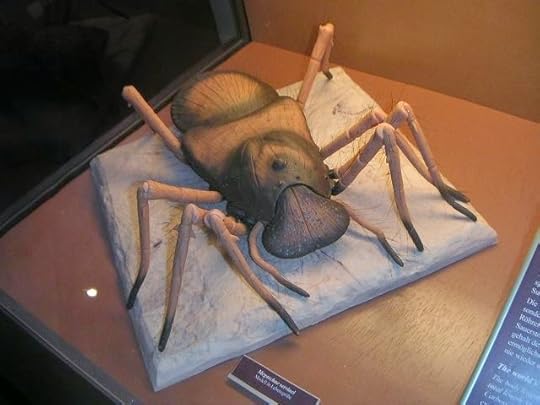 Megarachne model constructed when Megarachne was thought to have been a giant spider (© Markus Bühler)
Megarachne model constructed when Megarachne was thought to have been a giant spider (© Markus Bühler) Some of the modern world's largest known spiders utilise a tracheal respiratory system, whereas smaller spiders employ flattened organs of passive respiration called book lungs. Yet neither system is sufficiently competent to enable spiders to attain enormous sizes, based upon current knowledge at least. So if a giant spider does thrive in some secluded, far-off realm, it must have evolved a radically different, much more advanced respiratory system, not just a greatly enlarged body.
GIANT CRABS, NOT GIANT SPIDERS?
Interestingly, there is a notable precedent for the development of a novel respiratory organ among large land-dwelling arthropods. The largest of all such species living today is the coconut crab Birgus latro, which sports a body length of up to 16 in, a weight of up to 9 lb, and a leg span of more than 3 ft. Indigenous to various islands in the Indian and Pacific Oceans, despite being a crab it is exclusively terrestrial (it cannot swim and will drown if immersed in water for over an hour), and has evolved a unique respiratory organ known as a branchiostegal lung that enables it to exist entirely on land, and which developmentally can be seen as midway between gills and true lungs.
So who knows, if crustaceans (which are predominantly aquatic arthropods) can achieve this during evolution, perhaps spiders (which are predominantly terrestrial anyway) have also achieved something comparable. Moreover, it has suggested that perhaps some reports of so-called giant spiders are actually sightings of giant land crabs, but crabs are very different in appearance from spiders, due in no small way to their instantly visible pincers, and no such crabs are known to exist in any of the regions from which the giant spiders documented here have been reported.
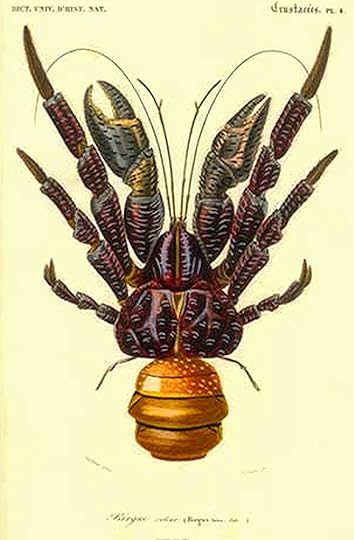 Coconut crab, depicted in Dictionnaire d'Histoire Naturelle (1849)
Coconut crab, depicted in Dictionnaire d'Histoire Naturelle (1849)All of this, however, is sheer speculation, and is likely to remain so – unless, for instance, in the not-too-distant future a Baka pygmy should happen not only to kill a j'ba fofi but also to preserve its body afterwards, and duly alert scientific attention to it. Then at last we might have the long-awaited solution to this fascinating mystery – although arachnophobes might be more than happy for it to remain unsolved indefinitely!
This ShukerNature blog article is excerpted from an entire and exceedingly extensive chapter on giant mystery spiders – indeed, the most comprehensive coverage of such cryptids ever compiled and published – in my book Mirabilis: ACarnival of Cryptozoology anf Unnatural History (Anomalist Books: New York, 2013), which contains several additional examples. So be sure to check it out (unless of course you're seriously arachnophobic, in which case it may not be a good idea to do so!).
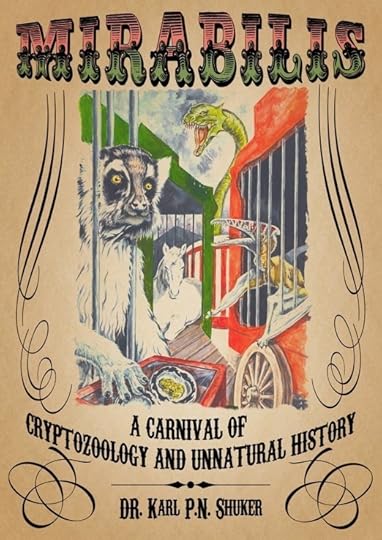
Published on July 29, 2014 18:58
July 28, 2014
THE MPISIMBI – A NOW-EXTINCT KING CHEETAH STRAIN IN EAST AFRICA?
 Painting of the king cheetah's type specimen as imagined in life, from PZSL, 1927 (public domain)
Painting of the king cheetah's type specimen as imagined in life, from PZSL, 1927 (public domain)How tragic it is that such wonderful creatures have no concept, no awareness, of just how beautiful and magical they are.
Then again, perhaps they do - after all, they are cats...
Karl Shuker - Re king cheetahs, posted on his Facebook wall, 31 July 2010
Many mysterious African animals once thought to be legendary or wholly imaginary monsters solely confined to the realms of native folklore and superstition have ultimately been found to be real (albeit elusive) creatures that have successfully eluded formal scientific recognition until modern times. The mountain gorilla, okapi, giant forest hog, and pygmy hippopotamus were all dismissed as myths by Western science until the 20th Century. So too was another bizarre beast - the leopard-hyaena or nsui-fisi...until 1926.
UNMASKING THE NSUI-FISI
This was when a short letter penned by Major A.C. Cooper from Salisbury (now Harare) in Rhodesia (now Zimbabwe) was published by The Field, alongside his photograph of an extraordinary cat skin. Cooper believed the skin to be from a crossbreed of leopard and cheetah, which had been trapped at Macheke, about 62 miles southeast of Salisbury, but he was astonished by the exceptionally ornate markings adorning its golden-yellow coat, which were unlike those of any cat previously recorded by science. Upon its flanks and upper limbs they consisted of graceful curved stripes and abstract blotches, whereas a series of longitudinal stripes ran from its neck and shoulders along the entire length of its back to the upper portion of its tail, and a succession of thick black stripes encircled the remainder of its tail. Also of note were its non-retractile claws (a cheetah characteristic), and a mane-like ruff round its neck.
 Back view of a king cheetah, revealing its very eyecatching longitudinal dorsal stripes (© Steve Jurvetson-Wikipedia-Flickr)
Back view of a king cheetah, revealing its very eyecatching longitudinal dorsal stripes (© Steve Jurvetson-Wikipedia-Flickr)This wonderful creature matched traditional tribal descriptions of a strange monster termed the nsui-fisi (‘leopard-hyaena’), which was fervently claimed by Rhodesian natives to be the rare, exotic progeny of liaisons between leopards and hyaenas, as it was said by them to be as lithe, swift, and cunning as a leopard but boldly barred like the striped hyaena Hyaena hyaena. Such an identity was zoologically impossible, of course, but the fact remained that Cooper's mysterious big cat was still unexplained.
Not surprisingly, it soon attracted the attention of felid specialist Reginald Pocock, from the British Museum (Natural History), who identified it from Cooper's photograph as an aberrant leopard. (Interestingly, during the early years of the 20th Century, cats just like it had apparently been well known to locals in the Mazoe area of Rhodesia's northern region, where they were referred to as Mazoe leopards.) Once he was able to examine the skin itself, however, he swiftly changed his mind, recognising it to be from a cheetah - albeit one with dramatically different coat markings from the familiar polka-dot pelage of the normal cheetah Acinonyx jubatus. In 1927, Pocock announced that the skin represented a new species, which, due to its regal appearance and vaguely leonine mane, he dubbed Acinonyx rex - the king cheetah.
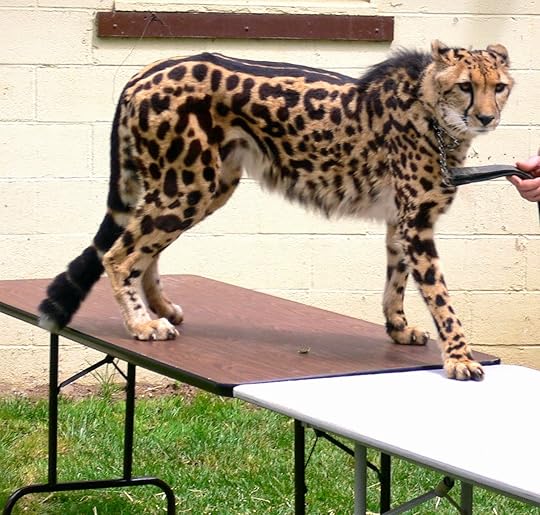 King cheetah (© Steve Jurvetson-Wikipedia-Flickr)
King cheetah (© Steve Jurvetson-Wikipedia-Flickr)During the next few years, several other king cheetah skins were obtained - all from a triangle of terrain enclosing eastern and southern Zimbabwe, northern South Africa, and eastern Botswana - but as the number of skins increased, it became evident that some of these were intermediate in appearance between normal cheetahs and the first king cheetah, documented by Major Cooper. In other words, there was no longer a clear morphological demarcation line between spotted cheetahs and the striped king cheetah. This could mean only one thing - the king cheetah was not a distinct species in its own right after all. Instead, it was merely a freak mutant variety of the normal cheetah - which Pocock conceded in 1939.
As a result, interest in the king cheetah waned, and after a time reports of such specimens rarely emerged. Indeed, by the 1970s some zoologists had begun to fear that this handsome striped strain had died out, but during the 1970s a king was filmed living with normal cheetahs in the Kruger National Park.
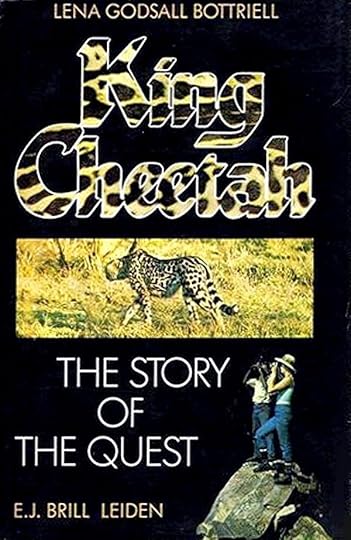 The 1970s Kruger-inhabiting king cheetah individual, as featured on the front cover of leading king cheetah researcher Lena Bottriell's definitive book, King Cheetah (1987)
The 1970s Kruger-inhabiting king cheetah individual, as featured on the front cover of leading king cheetah researcher Lena Bottriell's definitive book, King Cheetah (1987)Today, there is no doubt that the king cheetah is indeed alive and well, with several specimens having been born within litters of normal spotted cheetahs in captivity in South Africa.
THE GENETICS OF A KING
Since its scientific discovery, there has been a great deal of conflict concerning the king cheetah's taxonomic status. At first it was believed to be a hybrid of leopard and cheetah, then a valid species, and ultimately a mutant form of the normal cheetah. In May 1981, however, the de Wildt Cheetah Breeding and Research Centre of Pretoria's National Zoological Gardens was able to examine this issue in a thorough manner, when a king cheetah was unexpectedly born to a pair of normal cheetahs here. A few days later, moreover, a second king was born, this time to the sister of the first king's mother.
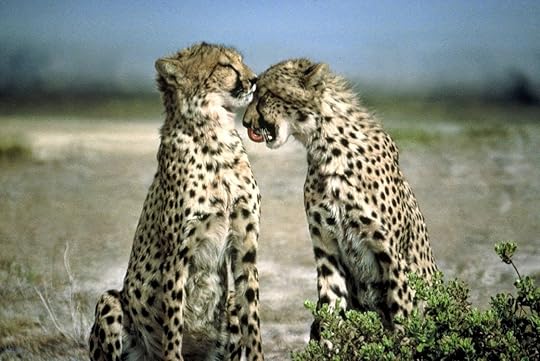 Two normal spotted cheetahs
Two normal spotted cheetahsThese fortuitous events duly initiated a programme of monitored breeding conducted at the centre, in order to determine the genetic basis of the king cheetah phenotype. By 1986, it had become clear that a recessive mutant allele was responsible, equivalent to the recessive allele producing the blotched tabby coat pattern in domestic cats. In other words, only cheetahs with two copies of the 'king' allele are kings. Cheetahs with one copy of the king allele and one of the normal (wild-type) spotted allele, or cheetahs with two copies of the spotted allele and none of the king allele, are normal spotted cheetahs.
Moreover, in a paper published by the journal Science in September 2012, a team of American genetics researchers from several different institutes revealed that they had identified the specific gene responsible for the king cheetah's striped coat pattern and the blotched coat pattern in domestic tabby cats. Both are caused by a recessive mutation in a gene dubbed Taqpep by the researchers.
 Close-up of a king cheetah's fur, revealing its blotched-tabby-homologous pelage markings (© Wegmann/Wikipedia)
Close-up of a king cheetah's fur, revealing its blotched-tabby-homologous pelage markings (© Wegmann/Wikipedia)And so, one mystery concerning the king cheetah is a mystery no more - but there are others that still await a solution, and none is more fascinating than the following example.
UNMASKING THE MPISIMBI?
What makes the king cheetah so memorable in addition to its incredibly beautiful coat is its extremely limited distribution. Many freak mutations of coat colour or patterning in mammals are spontaneous, i.e. they can arise abruptly in any population of a given species, regardless of geographical location. Yet whereas the typical spotted cheetah occurs in southern, eastern, central, northern, and western Africa, king cheetahs have never been reported conclusively outside southern Africa – or have they?
There are two possible and potentially extremely significant exceptions to this widely-assumed rule (and three, if we consider some remarkable evidence that I lately uncovered for the erstwhile presence of at least one king cheetah specimen in the wild not anywhere in Africa, but instead in Asia, and which in 2013 I formally documented in Vol. 2 of the Journal of Cryptozoology, whose logo, very aptly, is a king cheetah – click here for further details).
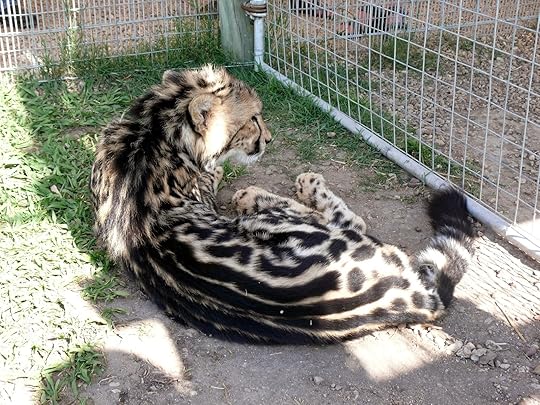 A young king cheetah (© DannyBlue/Deviantart)
A young king cheetah (© DannyBlue/Deviantart)The first possible exception to the king cheetah's strict zoogeographical limitation to southern Africa is a king cheetah skin that in 1988 turned up in the West African country of Burkina Faso. It supposedly came from a specimen that had been shot by a poacher in the northern end of the Singou Total Fauna Reserve. Some researchers wonder whether this mystifying skin is one that in reality originated in southern Africa but which later travelled northwest via itinerant poachers or other skin traders. Alternatively, however, could a 'king' strain of cheetah have spontaneously arisen in West Africa?
As for the second putative exception to the rule of the king cheetah being exclusively southern African in distribution, this is one that has never been publicly revealed – until now. It features an extremely obscure East/Central African mystery beast known as the mpisimbi
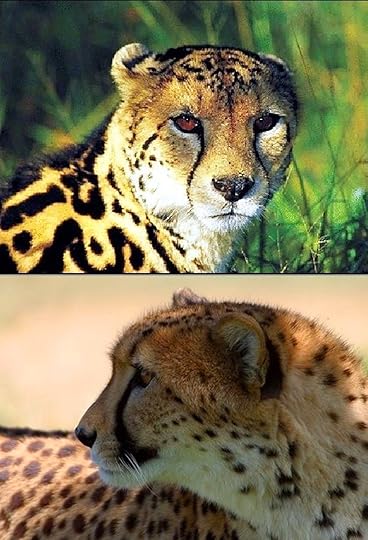 King cheetah head (above) and normal spotted cheetah head (below)
King cheetah head (above) and normal spotted cheetah head (below)In 1927, Chambers’s Journal published a fascinating article on East and Central African mystery beasts entitled ‘On the Trail of the Brontosaurus and Co.’. It was written by ‘Fulahn’, the pen-name of Captain William Hichens - a man whose name should already be familiar to mystery cat aficionados. For he was none other than the Native Magistrate at Lindi, Tanzania, during the 1920s and 1930s who investigated a succession of particularly gruesome murders there attributed by the local people to a giant brindled mystery cat known as the nunda or mngwa (click here for a ShukerNature blog post devoted to this feline cryptid).
Most of the cryptids documented by Hichens in his Chambers's Journal article are relatively famous ones, with one notable exception. Contained within his account are a couple of tantalising lines that have fascinated and frustrated me in equal measures for many years:
"But such are the mystery animals. There are others – the mpisimbi, the leopard-hyaena, which eats sugar-cane, and which I have hunted many a weary night without success;"
Despite numerous searches, I have never been able to uncover any additional information concerning this enigmatic creature. So what exactly is the mpisimbi?
 King cheetahs (© David Pepper-Edwards)
King cheetahs (© David Pepper-Edwards)The above-quoted lines offer no morphological description whatsoever of the mpisimbi. Conversely, its name’s English translation – ‘leopard-hyaena’ - is very intriguing, because it corresponds precisely with the English translation of the king cheetah’s native South African name, nsui-fisi. Moreover, Hichens’s unusual claim that the mpisimbi eats sugar-cane adds further to a putative link between the mpisimbi and the king cheetah, because in a second article, published under his own name a year later in Wide World Magazine, Hichens stated: “The Nsuifisi, or striped cheetah...was also reputed to be a raider of grain and sugar-cane”.
Of course, as Hichens went on to discuss, because cheetahs are carnivores it seems improbable that they would raid grain-plots. And even though hyaenas are notorious scavengers with an extremely catholic diet, they are not known to attack standing crops, but they will certainly devour cooked grain, vegetables, and even boiled flour.
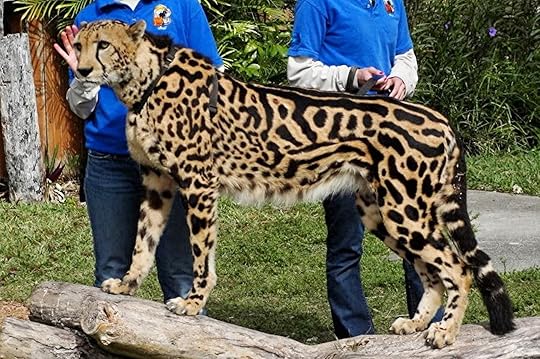 King cheetah (© AKovacs23/Photobucket)
King cheetah (© AKovacs23/Photobucket)Such considerations and qualifications, however, are not significant with regard to the cryptozoological mystery under review here. What is significant is that both the mpisingi and the nsui-fisi were claimed, rightly or wrongly, by the native tribes in their respective, separate areas of Africa to consume the very same unexpected foodstuff – sugar-cane.
Is it conceivable, therefore, that the mpisimbi and the nsui-fisi are indeed one and the same creature – namely, the king cheetah? If so, it suggests that at some time in the distant past, striped cheetahs did exist in East and/or Central Africa – although, with no modern-day reports of such beasts on file, even if they once did exist there they seemingly no longer do. Put another way: whatever it may have been, tragically the mpisimbi is now apparently extinct.
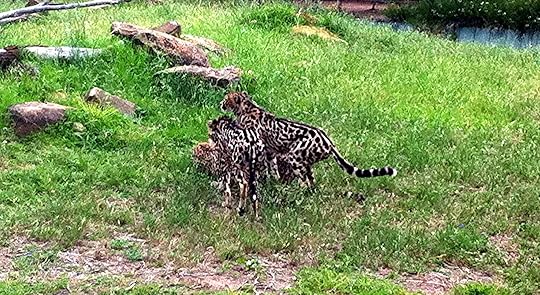 King cheetahs (© David Pepper-Edwards)
King cheetahs (© David Pepper-Edwards)Of course, sceptics may well claim that this is all supposition, but the presence of those brief lines regarding the mpisimbi in Hichens’s article means that the possibility of mpisimbi and king cheetah synonymity, however remote it may seem, cannot be discounted.
Moreover, who can say whether, in the future, a king cheetah or two will not spontaneously arise in the East African population of the normal spotted cheetah? That is, after all, what spontaneous mutations do!
At present, however, the mystery of the mpisimbi's zoological identity remains yet another enigma in the eventful history of Africa's extraordinary striped cheetah - the once (and future?) king.
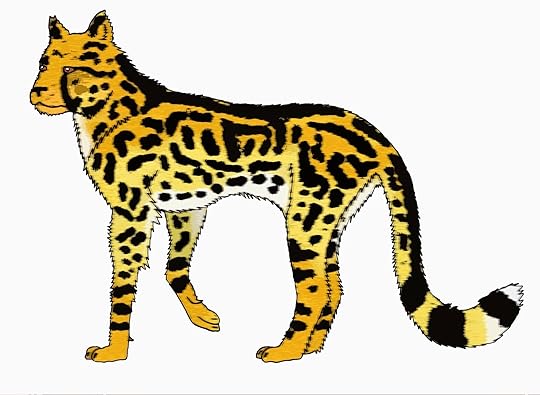 Diagrammatic representation of the king cheetah's ornate pelage patterning (© Tim Morris)
Diagrammatic representation of the king cheetah's ornate pelage patterning (© Tim Morris)For plenty of fascinating additional information concerning king cheetahs and other exotic cheetah varieties (including woolly cheetahs, blue-spotted cheetahs, black cheetahs, and unspotted cheetahs or cheetalines, be sure to check out my two dedicated crypto-cat books – Mystery Cats of the World (Robert Hale: London, 1989) and Cats of Magic, Mythology, and Mystery (CFZ Press: Bideford, 2012).

Published on July 28, 2014 10:59
THE MPISIMBI – AN UNDISCOVERED BUT NOW-EXTINCT KING CHEETAH STRAIN IN EAST AFRICA?
 Painting of the king cheetah's type specimen as imagined in life, from PZSL, 1927 (public domain)
Painting of the king cheetah's type specimen as imagined in life, from PZSL, 1927 (public domain)How tragic it is that such wonderful creatures have no concept, no awareness, of just how beautiful and magical they are.
Then again, perhaps they do - after all, they are cats...
Karl Shuker - Re king cheetahs, posted on his Facebook wall, 31 July 2010
Many mysterious African animals once thought to be legendary or wholly imaginary monsters solely confined to the realms of native folklore and superstition have ultimately been found to be real (albeit elusive) creatures that have successfully eluded formal scientific recognition until modern times. The mountain gorilla, okapi, giant forest hog, and pygmy hippopotamus were all dismissed as myths by Western science until the 20th Century. So too was another bizarre beast - the leopard-hyaena or nsui-fisi...until 1926.
UNMASKING THE NSUI-FISI
This was when a short letter penned by Major A.C. Cooper from Salisbury (now Harare) in Rhodesia (now Zimbabwe) was published by The Field, alongside his photograph of an extraordinary cat skin. Cooper believed the skin to be from a crossbreed of leopard and cheetah, which had been trapped at Macheke, about 62 miles southeast of Salisbury, but he was astonished by the exceptionally ornate markings adorning its golden-yellow coat, which were unlike those of any cat previously recorded by science. Upon its flanks and upper limbs they consisted of graceful curved stripes and abstract blotches, whereas a series of longitudinal stripes ran from its neck and shoulders along the entire length of its back to the upper portion of its tail, and a succession of thick black stripes encircled the remainder of its tail. Also of note were its non-retractile claws (a cheetah characteristic), and a mane-like ruff round its neck.
 Back view of a king cheetah, revealing its very eyecatching longitudinal dorsal stripes (© Steve Jurvetson-Wikipedia-Flickr)
Back view of a king cheetah, revealing its very eyecatching longitudinal dorsal stripes (© Steve Jurvetson-Wikipedia-Flickr)This wonderful creature matched traditional tribal descriptions of a strange monster termed the nsui-fisi (‘leopard-hyaena’), which was fervently claimed by Rhodesian natives to be the rare, exotic progeny of liaisons between leopards and hyaenas, as it was said by them to be as lithe, swift, and cunning as a leopard but boldly barred like the striped hyaena Hyaena hyaena. Such an identity was zoologically impossible, of course, but the fact remained that Cooper's mysterious big cat was still unexplained.
Not surprisingly, it soon attracted the attention of felid specialist Reginald Pocock, from the British Museum (Natural History), who identified it from Cooper's photograph as an aberrant leopard. (Interestingly, during the early years of the 20th Century, cats just like it had apparently been well known to locals in the Mazoe area of Rhodesia's northern region, where they were referred to as Mazoe leopards.) Once he was able to examine the skin itself, however, he swiftly changed his mind, recognising it to be from a cheetah - albeit one with dramatically different coat markings from the familiar polka-dot pelage of the normal cheetah Acinonyx jubatus. In 1927, Pocock announced that the skin represented a new species, which, due to its regal appearance and vaguely leonine mane, he dubbed Acinonyx rex - the king cheetah.
 King cheetah (© Steve Jurvetson-Wikipedia-Flickr)
King cheetah (© Steve Jurvetson-Wikipedia-Flickr)During the next few years, several other king cheetah skins were obtained - all from a triangle of terrain enclosing eastern and southern Zimbabwe, northern South Africa, and eastern Botswana - but as the number of skins increased, it became evident that some of these were intermediate in appearance between normal cheetahs and the first king cheetah, documented by Major Cooper. In other words, there was no longer a clear morphological demarcation line between spotted cheetahs and the striped king cheetah. This could mean only one thing - the king cheetah was not a distinct species in its own right after all. Instead, it was merely a freak mutant variety of the normal cheetah - which Pocock conceded in 1939.
As a result, interest in the king cheetah waned, and after a time reports of such specimens rarely emerged. Indeed, by the 1970s some zoologists had begun to fear that this handsome striped strain had died out, but during the 1970s a king was filmed living with normal cheetahs in the Kruger National Park.
 The 1970s Kruger-inhabiting king cheetah individual, as featured on the front cover of leading king cheetah researcher Lena Bottriell's definitive book, King Cheetah (1987)
The 1970s Kruger-inhabiting king cheetah individual, as featured on the front cover of leading king cheetah researcher Lena Bottriell's definitive book, King Cheetah (1987)Today, there is no doubt that the king cheetah is indeed alive and well, with several specimens having been born within litters of normal spotted cheetahs in captivity in South Africa.
THE GENETICS OF A KING
Since its scientific discovery, there has been a great deal of conflict concerning the king cheetah's taxonomic status. At first it was believed to be a hybrid of leopard and cheetah, then a valid species, and ultimately a mutant form of the normal cheetah. In May 1981, however, the de Wildt Cheetah Breeding and Research Centre of Pretoria's National Zoological Gardens was able to examine this issue in a thorough manner, when a king cheetah was unexpectedly born to a pair of normal cheetahs here. A few days later, moreover, a second king was born, this time to the sister of the first king's mother.
 Two normal spotted cheetahs
Two normal spotted cheetahsThese fortuitous events duly initiated a programme of monitored breeding conducted at the centre, in order to determine the genetic basis of the king cheetah phenotype. By 1986, it had become clear that a recessive mutant allele was responsible, equivalent to the recessive allele producing the blotched tabby coat pattern in domestic cats. In other words, only cheetahs with two copies of the 'king' allele are kings. Cheetahs with one copy of the king allele and one of the normal (wild-type) spotted allele, or cheetahs with two copies of the spotted allele and none of the king allele, are normal spotted cheetahs.
Moreover, in a paper published by the journal Science in September 2012, a team of American genetics researchers from several different institutes revealed that they had identified the specific gene responsible for the king cheetah's striped coat pattern and the blotched coat pattern in domestic tabby cats. Both are caused by a recessive mutation in a gene dubbed Taqpep by the researchers.
 Close-up of a king cheetah's fur, revealing its blotched-tabby-homologous pelage markings (© Wegmann/Wikipedia)
Close-up of a king cheetah's fur, revealing its blotched-tabby-homologous pelage markings (© Wegmann/Wikipedia)And so, one mystery concerning the king cheetah is a mystery no more - but there are others that still await a solution, and none is more fascinating than the following example.
UNMASKING THE MPISIMBI?
What makes the king cheetah so memorable in addition to its incredibly beautiful coat is its extremely limited distribution. Many freak mutations of coat colour or patterning in mammals are spontaneous, i.e. they can arise abruptly in any population of a given species, regardless of geographical location. Yet whereas the typical spotted cheetah occurs in southern, eastern, central, northern, and western Africa, king cheetahs have never been reported conclusively outside southern Africa – or have they?
There are two possible and potentially extremely significant exceptions to this widely-assumed rule (and three, if we consider some remarkable evidence that I lately uncovered for the erstwhile presence of at least one king cheetah specimen in the wild not anywhere in Africa, but instead in Asia, and which in 2013 I formally documented in Vol. 2 of the Journal of Cryptozoology, whose logo, very aptly, is a king cheetah – click here for further details).
 A young king cheetah (© DannyBlue/Deviantart)
A young king cheetah (© DannyBlue/Deviantart)The first possible exception to the king cheetah's strict zoogeographical limitation to southern Africa is a king cheetah skin that in 1988 turned up in the West African country of Burkina Faso. It supposedly came from a specimen that had been shot by a poacher in the northern end of the Singou Total Fauna Reserve. Some researchers wonder whether this mystifying skin is one that in reality originated in southern Africa but which later travelled northwest via itinerant poachers or other skin traders. Alternatively, however, could a 'king' strain of cheetah have spontaneously arisen in West Africa?
As for the second putative exception to the rule of the king cheetah being exclusively southern African in distribution, this is one that has never been publicly revealed – until now. It features an extremely obscure East/Central African mystery beast known as the mpisimbi
 King cheetah head (above) and normal spotted cheetah head (below)
King cheetah head (above) and normal spotted cheetah head (below)In 1927, Chambers’s Journal published a fascinating article on East and Central African mystery beasts entitled ‘On the Trail of the Brontosaurus and Co.’. It was written by ‘Fulahn’, the pen-name of Captain William Hichens - a man whose name should already be familiar to mystery cat aficionados. For he was none other than the Native Magistrate at Lindi, Tanzania, during the 1920s and 1930s who investigated a succession of particularly gruesome murders there attributed by the local people to a giant brindled mystery cat known as the nunda or mngwa (click here for a ShukerNature blog post devoted to this feline cryptid).
Most of the cryptids documented by Hichens in his Chambers's Journal article are relatively famous ones, with one notable exception. Contained within his account are a couple of tantalising lines that have fascinated and frustrated me in equal measures for many years:
"But such are the mystery animals. There are others – the mpisimbi, the leopard-hyaena, which eats sugar-cane, and which I have hunted many a weary night without success;"
Despite numerous searches, I have never been able to uncover any additional information concerning this enigmatic creature. So what exactly is the mpisimbi?
 King cheetahs (© David Pepper-Edwards)
King cheetahs (© David Pepper-Edwards)The above-quoted lines offer no morphological description whatsoever of the mpisimbi. Conversely, its name’s English translation – ‘leopard-hyaena’ - is very intriguing, because it corresponds precisely with the English translation of the king cheetah’s native South African name, nsui-fisi. Moreover, Hichens’s unusual claim that the mpisimbi eats sugar-cane adds further to a putative link between the mpisimbi and the king cheetah, because in a second article, published under his own name a year later in Wide World Magazine, Hichens stated: “The Nsuifisi, or striped cheetah...was also reputed to be a raider of grain and sugar-cane”.
Of course, as Hichens went on to discuss, because cheetahs are carnivores it seems improbable that they would raid grain-plots. And even though hyaenas are notorious scavengers with an extremely catholic diet, they are not known to attack standing crops, but they will certainly devour cooked grain, vegetables, and even boiled flour.
 King cheetah (© AKovacs23/Photobucket)
King cheetah (© AKovacs23/Photobucket)Such considerations and qualifications, however, are not significant with regard to the cryptozoological mystery under review here. What is significant is that both the mpisingi and the nsui-fisi were claimed, rightly or wrongly, by the native tribes in their respective, separate areas of Africa to consume the very same unexpected foodstuff – sugar-cane.
Is it conceivable, therefore, that the mpisimbi and the nsui-fisi are indeed one and the same creature – namely, the king cheetah? If so, it suggests that at some time in the distant past, striped cheetahs did exist in East and/or Central Africa – although, with no modern-day reports of such beasts on file, even if they once did exist there they seemingly no longer do. Put another way: whatever it may have been, tragically the mpisimbi is now apparently extinct.
 King cheetahs (© David Pepper-Edwards)
King cheetahs (© David Pepper-Edwards)Of course, sceptics may well claim that this is all supposition, but the presence of those brief lines regarding the mpisimbi in Hichens’s article means that the possibility of mpisimbi and king cheetah synonymity, however remote it may seem, cannot be discounted.
Moreover, who can say whether, in the future, a king cheetah or two will not spontaneously arise in the East African population of the normal spotted cheetah? That is, after all, what spontaneous mutations do!
At present, however, the mystery of the mpisimbi's zoological identity remains yet another enigma in the eventful history of Africa's extraordinary striped cheetah - the once (and future?) king.
 Diagrammatic representation of the king cheetah's ornate pelage patterning (© Tim Morris)
Diagrammatic representation of the king cheetah's ornate pelage patterning (© Tim Morris)For plenty of fascinating additional information concerning king cheetahs and other exotic cheetah varieties (including woolly cheetahs, blue-spotted cheetahs, black cheetahs, and unspotted cheetahs or cheetalines, be sure to check out my two dedicated crypto-cat books – Mystery Cats of the World (Robert Hale: London, 1989) and Cats of Magic, Mythology, and Mystery (CFZ Press: Bideford, 2012).

Published on July 28, 2014 10:59
July 26, 2014
THE DEADLY DODU OF CAMEROON – A BELLIGERENT GRUB-EATING BIGFOOT?
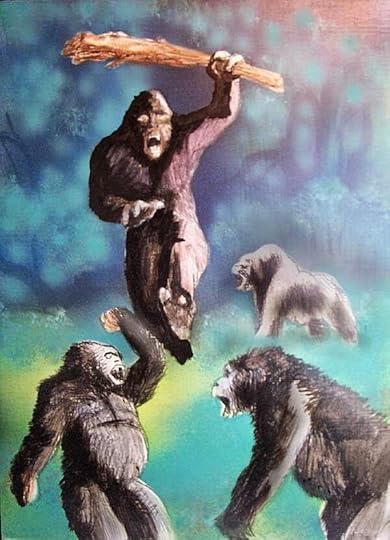 Artistic representation of the dodu (© William Rebsamen)
Artistic representation of the dodu (© William Rebsamen)Veteran cryptozoological explorer Bill Gibbons has searched for a number of notable mystery beasts in the field over the years, such as the Congo's mokele-mbembe (click here ) and emela-ntouka (click here for some remarkable new finds re this cryptid). He has also brought several hitherto-obscure examples to widespread cryptozoological attention, including Nepal's crocodile-jawed limbless 'dragons' (click here ), the New Guinea pterodactyl-like ropen (click here ), and the giant Congolese spider or j'ba fofi (comprehensively documented in my book Mirabilis , 2013). What must surely be among the most unusual , however, is of the man-beast variety.
While exploring southern Cameroon, in western Africa, seeking reports of mokele-mbembe-type cryptids during April 2000, Bill was informed by the Baka pygmies and Bantus there of a dangerous primate known to them as the dodu. They claimed that it is dark grey in colour, stands up to 6 ft tall, is mostly bipedal but will sometimes knuckle-walk on all fours, and, of particular note, has only three fingers on each hand and just three clawed toes on each foot. This last-mentioned feature provides an unexpected parallel with the puzzling reports of three-toed bigfoot or sasquatch prints sometimes encountered in North America.
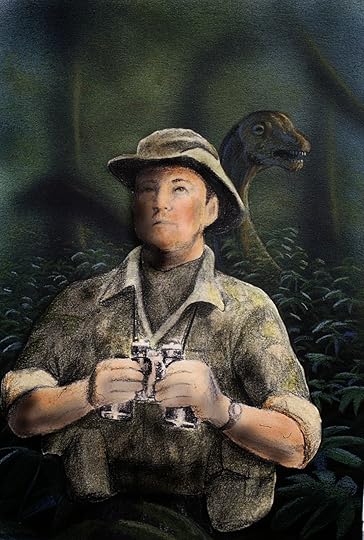 Painting of Bill Gibbons with mokele-mbembe (© William Rebsamen)
Painting of Bill Gibbons with mokele-mbembe (© William Rebsamen)Highly aggressive, a dodu will attack gorillas, but has an extremely unusual dietary predilection. After killing an antelope or some other sizeable prey, it does not touch the carcase. Instead, the dodu abandons it for a while, leaving the rotting carcase to fill with maggots, after which the dodu returns, scoops the grubs out, and eats them in quantity. It is also well known for leaving piles of sticks on the forest floor, which, as Bill speculates, may be a form of territorial marking behaviour.
Bill has collected several native reports of encounters with dodus, but by far the most remarkable was one that he heard when returning to Cameroon in 2001. While visiting the lower Boumba region, he was informed that a few months earlier, a group of white men, accompanied by pygmy trackers, had allegedly captured a live dodu, which was seen by residents of a town called Moloundou. Bill suspects that its captors were loggers, but what happened to this unique specimen following its capture (assuming that the report given to Bill was genuine) is unknown.
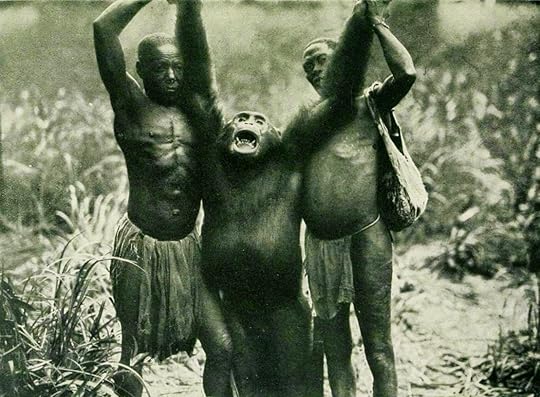 Vintage photograph depicting a dead Bili ape, from a German journal published in 1912
Vintage photograph depicting a dead Bili ape, from a German journal published in 1912 The prospect of such an entity still existing uncatalogued and unclassified by science in modern times might well seem highly implausible, but then again, that is precisely what sceptics thought about the lost giant apes of Bili too - until they were rediscovered in 1996 (click here ).
This ShukerNature blog post is excerpted from my book Karl Shuker's Alien Zoo (CFZ Press: Bideford, 2010).

Published on July 26, 2014 14:41
Karl Shuker's Blog
- Karl Shuker's profile
- 45 followers
Karl Shuker isn't a Goodreads Author
(yet),
but they
do have a blog,
so here are some recent posts imported from
their feed.



